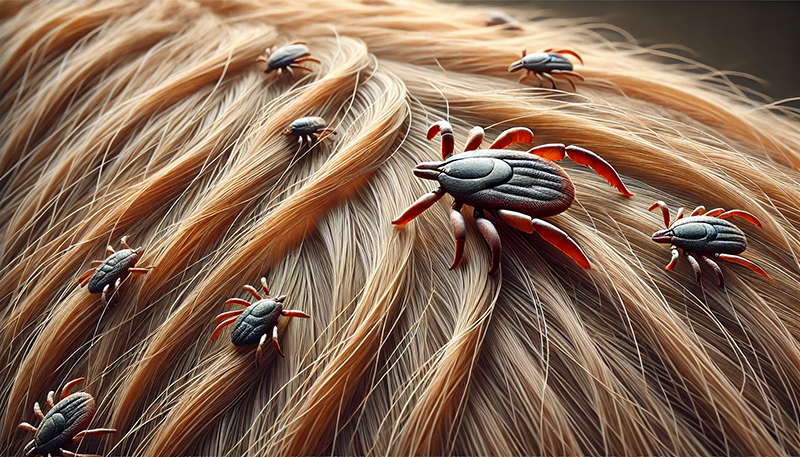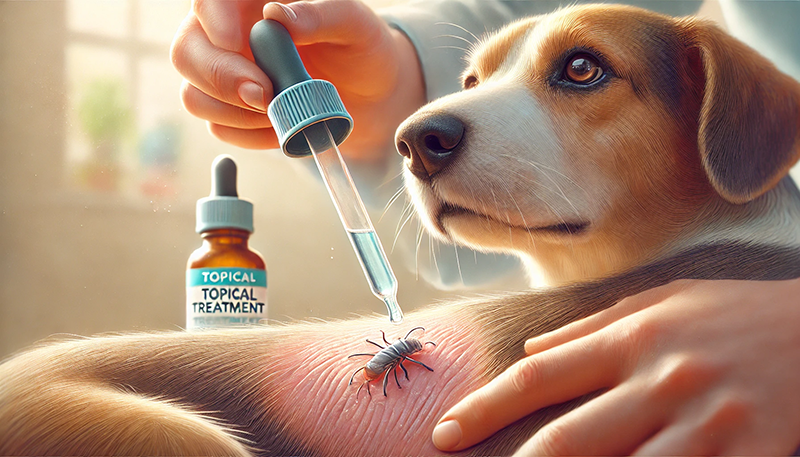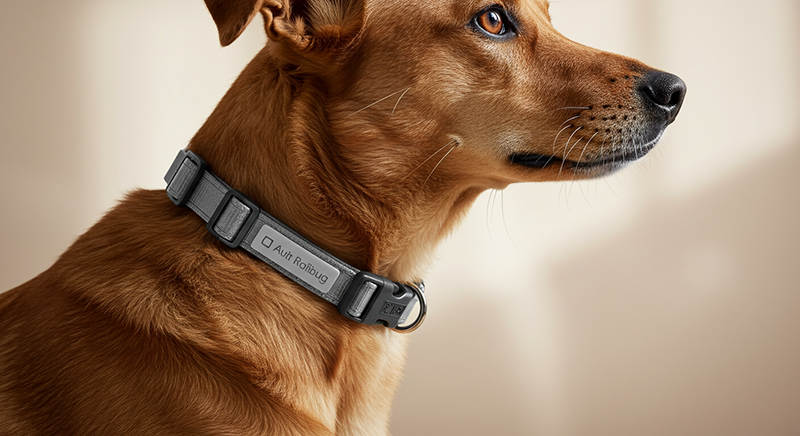Ticks on Dogs

Picture this: your furry best friend is enjoying a perfect day outdoors—bounding through the grass, chasing after squirrels, and basking in the sunshine. Then, you notice an unusual amount of scratching, and upon closer inspection, you find stealthy, clinging invaders making themselves at home in your dog’s fur. Yes, that’s right—ticks have crashed the party.
Ticks aren’t just a minor nuisance; they’re like unwelcome guests who not only show up uninvited but also bring a host of potential health hazards. These tiny parasites are more than merely annoying—they can seriously jeopardize your pooch’s well-being. Not only do they cause irritation and discomfort, but they can also transmit dangerous diseases such as Lyme disease, Rocky Mountain spotted fever, and tick paralysis.
How do these stealthy intruders infiltrate your dog’s peaceful life? Ticks are like covert agents, silently attaching themselves to your dog during outdoor adventures in wooded areas, tall grass, or even in your backyard. Once they latch on, they can remain hidden for days, feeding and potentially transmitting pathogens before you even notice. In no time, a single tick can lead to a significant infestation, leaving both you and your pet scrambling for a solution.
Overview of ticks and their impact on dogs
Scientific name: Ixodida spp
Ticks are among the most common parasites that affect dogs. Their bites do more than cause irritation—they can transmit several serious diseases and conditions, including Lyme disease, Ehrlichiosis, Anaplasmosis, Rocky Mountain spotted fever, and tick paralysis.
Distribution and Habitat: Ticks are prevalent across Europe, America, and Australia. Outdoors, they typically inhabit wooded areas, tall grasses, and brushy regions where they wait for passing hosts. Although they are less common indoors, ticks can still be inadvertently brought into your home on your pet, especially in areas like bedding where your dog rests.
Symptoms of a tick infestation
How can you tell if your beloved dog has picked up ticks? Tick bites can lead to serious, long-term health issues if left unchecked. Here are some signs to help you determine if ticks have found their way onto your pet.
Persistent Scratching
Just as tick bites cause relentless scratching, tick bites can also irritate your dog. If you notice your dog rubbing or scratching frequently—especially around the ears, neck, or between the toes—it could be a sign of tick activity.
Visible Ticks
Ticks are larger than ticks and often easier to spot. However, finding even one tick should alert you to the possibility of more hidden among your dog’s fur. Common hiding spots include areas like the armpits, behind the ears, or near the tail.
Engorged Bite Sites
As ticks feed, the area around the bite may appear red, swollen, or irritated. You might notice a darkened, enlarged spot where the tick is attached, which indicates it’s drawing blood.
Localized Hair Loss
While ticks themselves don’t directly cause hair loss, the irritation from their bites can lead to excessive scratching. This constant irritation may result in thinning hair or bald patches in areas where ticks are commonly found.
Dermatitis and Skin Inflammation
Repeated tick bites can cause localized dermatitis. This may present as redness, swelling, or even secondary infections if the skin becomes compromised. Dogs that are allergic to tick saliva may exhibit even more severe skin reactions.
Signs of Tick-Borne Diseases
Ticks can transmit a variety of illnesses, so watch out for additional symptoms such as fever, lethargy, joint pain, or even neurological signs like in tick paralysis. Diseases like Lyme disease, Ehrlichiosis, and Anaplasmosis might initially appear subtle, gradually worsening over time.
If you observe any of these signs, inspect your dog carefully for ticks and consult your veterinarian promptly. Early detection and treatment are crucial in preventing further health complications from tick infestations.
Topical Tick Treatments

When it comes to combating ticks, sometimes you need a frontline warrior – enter topical tick treatments. These convenient solutions come in forms such as spot-on applications, sprays, and powders, delivering targeted protection against these stealthy parasites. In this section, we’ll explore how topical tick treatments work, as well as their benefits and drawbacks.
Explanation of Topical Tick Treatments
Topical tick treatments are a popular choice among pet owners for effectively managing tick infestations in dogs. These products are typically applied as a spot-on solution—where a small amount of liquid is placed directly onto your dog’s skin, usually between the shoulder blades or along the back.
The active ingredients in these treatments work to repel and kill ticks, often disrupting their ability to attach and feed. When applied to your dog’s skin, the solution is absorbed into the natural oils and distributed across the body, offering long-lasting protection against ticks.
One of the major advantages of topical tick treatments is their ease of use. Most products come in pre-measured doses, ensuring you apply the right amount without any hassle. Additionally, many of these treatments are waterproof, meaning they continue to work effectively even after your dog bathes or goes swimming.
Another benefit is their versatility. Many topical tick treatments are formulated to not only target ticks but also provide protection against other pests such as ticks, mosquitoes, and lice. This comprehensive approach helps keep your dog safe from a range of parasites.
However, it’s important to note that while topical tick treatments are generally safe and effective when used as directed, some dogs may experience mild skin irritation or sensitivity at the application site. Always consult with your veterinarian before starting any new tick prevention regimen to ensure it’s the right choice for your pet.
Overall, topical tick treatments offer a convenient and reliable way to keep your dog tick-free and comfortable. With consistent use, you can protect your furry friend from the discomfort and potential health risks associated with tick infestations, allowing them to enjoy a healthier, safer life.
Pros and cons of using topical treatments
Pros
-
Effectiveness: Topical tick treatments are highly effective at eliminating adult ticks and preventing infestations. They act swiftly to remove existing ticks and provide long-lasting protection against re-infestation.
-
Convenience: These treatments are easy to administer, typically requiring just one application per month. This makes them an ideal option for busy pet owners who prefer effective tick control without the need for daily or weekly treatments.
-
Comprehensive Protection: In addition to targeting ticks, many topical treatments also protect against other parasites such as ticks, mosquitoes, and lice. This all-in-one approach helps keep your dog safe from a wide variety of pests.
-
Minimal Side Effects: When used as directed, topical tick treatments generally produce minimal side effects. While a few dogs might experience mild skin irritation or sensitivity at the application site, these reactions are usually rare and temporary.
Cons
-
Potential Skin Sensitivity: Some pointers may experience irritation or sensitivity from the ingredients in topical tick treatments. This reaction can show up as redness, itching, or inflammation at the application site. If your pointer has sensitive skin or a history of allergies, it’s wise to monitor them closely after applying the product.
-
Residue: Topical tick treatments can leave a residue on your pointer’s skin that may feel greasy or oily. While this residue is necessary for the product to be absorbed and work effectively, some dogs might find it uncomfortable or bothersome.
-
Odor: Certain topical tick treatments have a strong odor that may be unpleasant for both you and your pointer. Although this smell typically fades within a few hours, it can be irritating to those with sensitive noses.
-
Limited Coverage: Topical tick treatments are designed to protect against external parasites like ticks but do not prevent or treat internal parasites such as heartworms or intestinal worms. For comprehensive protection, additional products may be necessary to safeguard your pet from all types of parasites.
Oral Tick Medicines

Hassle-free tick control is as simple as giving your pointer a tasty treat. That’s the beauty of oral tick treatments. These convenient and effective solutions offer an easy way to protect your dog from tick infestations from the inside out. In this section, we’ll explore the world of oral tick treatments, detailing how they work, their advantages, and why they might be the perfect choice for your pup.
How it works
Oral tick treatments work by delivering active ingredients into your pointer’s bloodstream through ingestion. Once absorbed, these ingredients circulate throughout your dog’s body, targeting ticks when they feed on your pet’s blood.
The active components in these treatments typically disrupt the tick’s nervous system, impairing their ability to move, reproduce, and survive. This process effectively kills adult ticks and prevents tick eggs and larvae from developing into new parasites.
Unlike topical treatments that require direct application to the skin, oral tick treatments offer systemic protection—working from within. This makes them an excellent option for pointers who are difficult to handle or have sensitive skin.
Oral tick treatments come in various forms, including chewable tablets, flavored liquids, and pills. Many dogs find these forms palatable, making them easy to administer without any fuss.
One of the key advantages of oral tick treatments is their convenience. A single oral dose can provide your pointer with long-lasting protection against ticks for up to a month.
Additionally, these treatments are often fast-acting, with some products beginning to kill ticks within hours of ingestion. This rapid onset helps quickly eliminate existing tick infestations and provides your pointer with immediate relief.
Advantages and disadvantages of oral treatments
Advantages
-
Simple Administration:
Oral tick treatments are typically offered in appetizing forms like chewable tablets or flavored liquids, making it easy to administer them to your pointer without any hassle. -
Whole-Body Defense:
These treatments work systemically by entering your pointer’s bloodstream, ensuring that tick protection is delivered from the inside out—no need to apply anything directly to the skin. -
Convenient and Long-Lasting:
A single oral dose can provide tick protection for up to a month, streamlining your tick control routine and eliminating the need for frequent reapplications. -
Rapid Action:
Many oral tick treatments begin to work quickly, starting to eliminate ticks within hours of ingestion, which helps provide swift relief from any discomfort. -
No Residue:
Unlike topical solutions, oral tick treatments leave no residue on your pointer’s skin, so there’s no greasy or oily feeling after administration.
Disadvantages
-
Potential Side Effects:
Some pointers might experience mild side effects such as gastrointestinal upset (e.g., vomiting or diarrhea) or allergic reactions to the ingredients in oral tick treatments. It’s important to monitor your dog closely after administration. -
Limited Coverage:
Oral tick treatments are primarily designed to target adult ticks and may not effectively eliminate other parasites, such as ticks or mosquitoes. Additional products might be necessary for comprehensive parasite control. -
Cost:
Depending on the brand and dosage regimen, oral tick treatments can be more expensive than topical options or other tick control methods. This factor may be significant for pet owners on a tight budget. -
Not Suitable for All Dogs:
Some pointers may have difficulty swallowing chewable tablets or might refuse them due to taste preferences. In such cases, alternative tick control methods may need to be considered.
Tick Collars

Looking for a hands-off approach to tick control for your pointer? Meet tick collars – the wearable warriors in the battle against those elusive parasites! Tick collars provide a convenient and long-lasting solution for protecting your pup from ticks, ticks, and other unwelcome visitors. In this section, we’ll explore everything you need to know about tick collars, from their mechanism of action to their advantages and drawbacks.
Overview of Tick Collars and How They Work
Tick collars are a popular and practical method for controlling ticks in dogs, delivering continuous protection against ticks, ticks, and other biting pests. These collars are designed to be worn around your dog’s neck, where they steadily release active ingredients that repel and kill ticks on contact.
Tick collars work through a process called diffusion. The active ingredients slowly migrate through your dog’s skin and coat, forming a protective barrier that wards off ticks and other parasites. As your pointer moves and plays, natural friction and body heat help distribute the active compounds evenly, ensuring consistent and long-lasting defense.
The active ingredients in tick collars vary by brand and formulation but often include insecticides like imidacloprid, flumethrin, or deltamethrin. These chemicals target ticks by interfering with their nervous systems, ultimately leading to paralysis and death.
In addition to eliminating adult ticks, some tick collars are formulated to disrupt the tick life cycle by preventing eggs and larvae from developing into adults. This comprehensive strategy helps prevent re-infestation, keeping your pointer protected from ticks at every stage.
Tick collars are generally water-resistant, meaning they remain effective even if your dog gets wet while swimming or bathing. However, prolonged exposure to water may reduce their effectiveness, so it’s important to follow the manufacturer’s guidelines on water exposure.
Pros and cons of tick collars
Pros
-
Long-lasting Protection:
Tick collars deliver continuous defense against ticks for several months, depending on the product. This extended protection means you won’t have to reapply treatments frequently, ensuring your pointer is safeguarded around the clock. -
Convenience:
Tick collars are incredibly easy to use. Simply fasten the collar around your pointer’s neck, and you’re set! With no messy applications or monthly treatments to worry about, tick collars offer a hassle-free option for busy pet owners. -
Water-resistant:
Many tick collars are designed to be water-resistant, so they remain effective even after your pointer gets wet from swimming or bathing. This guarantees uninterrupted protection against ticks, regardless of your dog’s level of activity. -
Wide Coverage:
Tick collars provide comprehensive protection not only against ticks but often against other pests like ticks and mosquitoes as well. This multi-purpose approach to parasite control helps keep your pointer safe from a variety of unwelcome intruders. -
Cost-effective:
Compared to other tick control methods such as topical treatments or oral medications, tick collars are often more economical—especially when considering the long-lasting protection they offer.
Cons
-
Skin Irritation:
Some pointers may develop skin irritation or sensitivity from the collar material or the active ingredients in tick collars. This can show up as redness, itching, or swelling around the neck area. It’s important to monitor your dog after fitting the collar and consult your veterinarian if any adverse reactions occur. -
Limited Effectiveness:
Tick collars may be less effective in areas with heavy tick infestations or for dogs with thick or long coats, as the active ingredients might not be distributed evenly throughout the fur. In these cases, additional tick control measures may be needed for complete protection. -
Safety Concerns:
There have been occasional reports of issues with tick collars, such as accidental ingestion or entanglement. It’s essential to follow the manufacturer’s instructions carefully and regularly inspect the collar for any signs of wear or damage to ensure your pointer’s safety. -
Odor:
Some tick collars can emit a strong odor that may be unpleasant for both your pointer and you. While this smell typically dissipates over time, it can be bothersome for those with sensitive noses.
Tips for Tick Prevention
Ready to take proactive steps to keep those pesky ticks at bay? In this section, we’ll share invaluable tips and tricks for preventing tick infestations in your pointer. From smart yard maintenance practices to regular grooming routines, we’ve got you covered with everything you need to know to keep your pup tick-free and comfortable.
Practical Advice for Preventing Tick Infestations
Here’s some practical advice for preventing tick infestations:
-
Regular Grooming:
Keep a consistent grooming routine for your pointer by brushing their coat and carefully checking for ticks, especially around the ears, neck, and between the toes. Regular grooming not only helps remove any ticks that may have attached but also prevents them from settling in. -
Vacuuming:
Frequently vacuum your home, focusing on areas where your pointer spends most of their time, such as carpets, rugs, and furniture. This practice can help remove ticks that may have hitched a ride indoors, along with any eggs or larvae they might have dropped. -
Wash Bedding:
Regularly wash your pointer’s bedding, blankets, and toys in hot water. This helps eliminate ticks and any eggs that might be present, reducing potential breeding grounds and lowering the chance of re-infestation. -
Yard Maintenance:
Keep your yard tidy by mowing the lawn regularly and clearing away debris or clutter where ticks may hide. Consider using outdoor tick control products or hiring a professional pest control service to treat your yard, especially in tick-prone areas. -
Limit Exposure:
Minimize your pointer’s exposure to environments known for high tick activity, such as wooded areas, tall grass, and brushy or marshy regions. When you do venture into these areas, be sure to use tick prevention products to keep your dog protected. -
Tick Collars or Spot-on Treatments:
Use tick collars or spot-on treatments recommended by your veterinarian to provide continuous protection. These products release active ingredients that repel and kill ticks, helping to prevent infestations from taking hold. -
Regular Veterinary Check-ups:
Schedule routine veterinary visits to monitor your pointer’s overall health and discuss tick prevention options. Your veterinarian can recommend the most effective tick control products based on your dog’s age, health status, and lifestyle. -
Treat All Pets:
If you have multiple pets, ensure that each one receives appropriate tick prevention treatments regularly. Even if one pet shows no visible signs of ticks, they could still be carrying them and potentially spreading them to other animals in your household. -
Be Vigilant:
Stay alert for any signs of ticks on your pointer, such as excessive scratching or the discovery of ticks on their skin. Early detection and prompt removal are key to preventing larger infestations and minimizing the risk of tick-borne diseases.
Strategies for maintaining a tick-free environment

Practical Strategies for Preventing tick Infestations
-
Consistent Grooming:
Establish a regular grooming routine for your pointer by brushing their coat and carefully checking their skin for signs of ticks or tick dirt. Routine grooming helps remove any ticks and deters them from settling in. -
Frequent Vacuuming:
Vacuum your home often, concentrating on spots where your pointer spends most of their time—such as carpets, rugs, and furniture. Regular vacuuming removes tick eggs, larvae, and adults, thereby reducing the likelihood of an infestation. -
Bedding Cleaning:
Wash your pointer’s bedding, blankets, and toys in hot water on a regular basis. This practice eliminates any ticks or eggs present and helps eradicate potential breeding areas, preventing re-infestation. -
Yard Maintenance:
Keep your yard well-maintained by mowing frequently and removing debris or clutter where ticks might hide. You might also consider using outdoor tick control products or hiring a professional pest control service to treat your yard. -
Limiting Exposure:
Reduce your pointer’s contact with areas prone to tick activity, such as wooded regions, tall grass, and marshy spots. If you must visit these areas during peak tick season, be sure to apply preventive tick treatments to safeguard your dog. -
tick Collars or Spot-On Treatments:
Use tick collars or spot-on products recommended by your veterinarian to provide ongoing protection. These treatments contain active ingredients that repel and kill ticks, effectively preventing infestations. -
Regular Veterinary Check-ups:
Schedule routine visits with your veterinarian to monitor your pointer’s health and discuss tick prevention strategies. Your vet can suggest the most effective tick control products based on your dog’s age, health, and lifestyle. -
Treating All Household Pets:
If you have multiple pets, ensure that each one receives regular tick prevention treatments. Even if one pet doesn’t show visible signs of ticks, it could still harbor them and spread them to others. -
Stay Vigilant:
Keep an eye out for early signs of tick activity, such as persistent scratching, redness, or inflammation of the skin, along with small black specks (tick dirt) on your pointer’s fur. Prompt detection and treatment are essential to stop a minor issue from escalating into a severe infestation.




